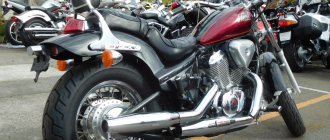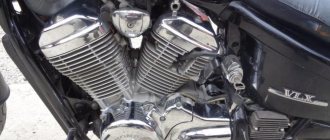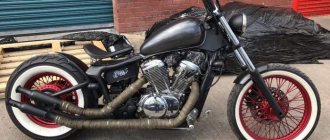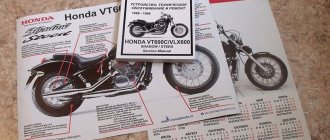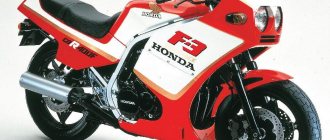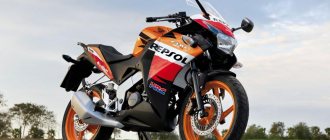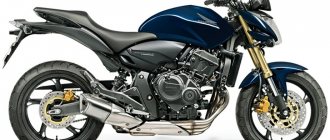- Honda motorcycle model
The Honda Steed 600 cruiser model was first introduced in 1988 and was produced until 1995 inclusive. The model was produced in parallel with the Honda Steed 400 and was aimed only at the domestic Japanese market. Outside Japan, the motorcycle was sold under the names Honda Shadow 600, Honda VT600C and others. The Japanese Steed 600 was designated NV600. In this review we will only be looking at the Steed 600 for the Japanese market, while the VT600 Shadow will be covered in a separate article.
The Honda Steed 600 model, unlike the Steed 400, could not be used by novice drivers, since it required a driver's license of a higher category. That is why the model was produced in significantly smaller quantities and had only one standard modification (named VLX).
The Steed 600 was produced until 1995 inclusive, without actually being seriously updated, after which it left the market. The success of the Steed 400/600 models in Japan was due to the boom in American-style motorcycles that began in the early 90s, which actually made the Steed series a bestseller - 80,000 motorcycles were produced and sold during its entire production.
The Steed 600 and Steed 400 models had a common base and differed only in the engine (increased volume, 36 hp and 44 Nm instead of 31 hp and 33 Nm) and carburetors (VDF1 instead of VDD0). An important feature of the Steed 600 is that it was produced only with a 4-speed gearbox. Both models are popular on the Russian market, but the 400 cc version is much larger. This is mainly due to the price and widespread availability of the Steed 400 in Japan. The differences between Steed 400 and Steed 600 are so minimal that often unscrupulous sellers sell a 400 cc version under the name Steed 600. Meanwhile, it is very easy to distinguish them by frame/engine numbers and the number of gears in the box:
Table: “Differences between Honda Steed 600 and Honda Steed 400.”
| Model | Honda Steed 600 | Honda Steed 400 |
| Frame number | PC21-XXXXXXXX | NC26/NC37-XXXXXXXX |
| Engine number | PD06E-XXXXXXX | NC25E-XXXXXXX |
| Transmission | 4-speed | 5-speed |
Brief history of the model
1988 - start of production and sales of the Honda Steed 600. Model: Honda Steed 600 VLX (Japan). Frame number: PC21-100XXXX~. Factory designation: NV600Cj.
1989 - no significant changes. Model: Honda Steed 600 VLX (Japan). Frame number: PC21-105XXXX~. Factory designation: NV600Ck.
1990 - a passenger backrest is standard equipment on the motorcycle. Model: Honda Steed 600 VLX (Japan). Frame number: PC21-110XXXX~. Factory designation: NV600Cl.
1991 - model not produced. 1992 - no significant changes. Model: Honda Steed 600 VLX (Japan). Frame number: PC21-115XXXX~. Factory designation: NV600Cn.
1993 - fuel tank capacity increases from 9 to 11 liters. Model: Honda Steed 600 VLX (Japan). Frame number: PC21-120XXXX~. Factory designation: NV600Cp.
1994 - no significant changes. Model: Honda Steed 600 VLX (Japan). Frame number: PC21-130XXXX~. Factory designation: NV600Cr.
1995 is the last year of production. This year's models feature a 3D Steed emblem on the fuel tank. Model: Honda Steed 600 VLX (Japan). Frame number: PC21-140XXXX~. Factory designation: NV600Ct.
1995-1996: Steed VLX (400/600), Steed VCL (400), Steed VSE (400)
Review of the history of Honda Steed and description of modifications for 1995-1996 on the official Japanese website
Comparison table of characteristics of Steed VLX (400/600), Steed VCL, Steed VSE on the official Japanese website
Changes have been made to the VLX modification. New modifications have been released: VCL and VSE. The engine remained unchanged, but significant changes were made to the exterior. American style is becoming more modern. The VSE modification comes in two-tone color, and the VCL comes in black. The VSE modification features a rear alloy wheel and a stylish seat shape.
Technical characteristics of Honda Steed 600:
| Model | Honda Steed 600 |
| Motorcycle type | cruiser |
| Year of issue | 1988-1995 |
| Frame | steel tubular |
| engine's type | 2-cylinder, 4-stroke, V-shaped |
| Working volume | 583 cm³ |
| Bore/Stroke | 75.0 x 66.0 mm |
| Compression ratio | 9.2:1 |
| Cooling | liquid |
| Number of valves per cylinder | SOHC, 3 valves per cylinder |
| Fuel supply system | carburetor, 2x Keihin 34 mm (VDF1) |
| Ignition type | transistor |
| Maximum power | 36.0 hp (26.5 kW) at 6500 rpm |
| Maximum torque | 44.0 Nm (4.5 kg*m) at 3000 rpm |
| Transmission | 4-speed |
| type of drive | chain |
| Front tire size | 100/90-19 (57S) |
| Rear tire size | 170/80-15 M/C (77S) |
| Front brakes | 1 disc, 296 mm, 2-piston caliper |
| Rear brakes | drum |
| Front suspension | telescopic fork |
| Rear suspension | pendulum with monoshock absorber |
| Motorcycle length | 2310 mm |
| Motorcycle width | 760 mm |
| Motorcycle height | 1130 mm |
| Wheelbase | 1600 mm |
| Seat height | 680 mm |
| Minimum ground clearance (clearance) | 140 mm |
| Acceleration to 100 km/h | 7.9 sec |
| Maximum speed | 150 km/h |
| Gas tank capacity | 9.0 l – Steed 600 (1988-1992) 11.0 l – Steed 600 (1993-1995) |
| Motorcycle weight (dry) | 196 kg – Steed 600 (1988-1989) 199 kg – Steed 600 (1990-1992) 201 kg – Steed 600 (1993) 204 kg – Steed 600 (1994-1995) |
| Motorcycle weight (curb) | 208 kg – Steed 600 (1988-1989) 211 kg – Steed 600 (1990-1992) 214 kg – Steed 600 (1993) 217 kg – Steed 600 (1994-1995) |
text from MotoReview No., 2008
: Vladimir Zdorov, photo: Dmitry Ivaikin
Honda Steed 400VLC: 398 cm3, 31 hp, 211 kg, 1998, RUB 132,000.
Suzuki 400 Intruder Volusia: 399 cm3, 32 hp, 237 kg, 2002, RUB 164,000.
Laws of dialectics
And, in fact, why not? I was recently told here that the world consists of more than just sportbikes, damn, who would have thought! Moreover, I confess, in my distant adolescence I had a dream, which, however, never came true... About a large, harsh motorcycle, always black, with an ornate horned steering wheel, with a “gynecologist’s appointment” seating position and with a male muffler, a dream any nymphomaniac. A reminder of the unfulfilled fantasy of a timid young man is the deadly heavy “leather jacket”, which occupies almost half of the entire closet, which, in an amicable way, would have been thrown out long ago, but the hand does not rise. It’s just that back then there weren’t such offers on the market, just as, in fact, there wasn’t even a market for motorcycles used by fans of Pokemon and algae... But now there is. Do you want an almost exact copy of H.-D. Street Bob, and even with a lever-spring (parallelogram) front fork? Or maybe you prefer a clone of the H.-D modification. Fat Boy? At the same time, the budget should not exceed, well, say, 160,000 rubles? Please – Honda Steed 400VLC and Suzuki 400 Intruder Volusia are already waiting for their buyers. And while the latter is still wandering around somewhere, it’s time to try to understand what both of these motorcycles are. Looking at the complex mechanism of the Honda front fork with disbelief, I decided to give it to a colleague at first, and in return received a fat guy, bloated with self-importance - a Suzuki 400 Intruder Volusia. It’s funny to sit almost on the ground, looking at the front wheel somewhere in front, but this is just a cost of permanent stay on sportbikes, a matter of time and habit. Usually, after about two hours you begin to feel quite natural on almost any motorcycle, except that this does not apply to scooters. In this connection, it should be noted that there were absolutely no complaints about the ergonomics of both Honda and Suzuki. Despite the modest cubic capacity, both motorcycles were built quite “adult-style”. Everything is very serious - thick muffler pipes, wide donuts of rear tires, an inexperienced viewer will not have even a shadow of doubt that these are at least 1000 cc vehicles. It's no surprise that in this segment, 90% of market success depends solely on design. So, we either have a classic version of a chopper with a narrow front wheel and a small donut at the back, respectively, a Honda Steed, or we get a completely different type - in America it has a lot of different definitions - from “cruiser” to “classic motorcycle” (wow they are so “classic”, heh...). For example, it seems to me that the “bobber” option is very suitable for the Suzuki Volusia. Just don’t need hundreds of stones thrown into my garden - I know very well that this definition applies to other representatives of chopper-shaped animals, I just liked the word. In terms of dynamics, both devices are approximately equal, up to 80 km/h there is some “movement”, which gradually fades away at around 120 km/h - it is not proper for the owners of such motorcycles to become like “plastic” ones rushing straight to hell. The higher gears here are quite “working”, but due to the small displacement of the engines, if you need any sudden acceleration or even ordinary “sluggish” overtaking, you won’t be able to “sit out” on them - you will have to push “down”. Although switching to third in both the Honda and Suzuki cases will not give the desired increase in acceleration - rather, the engine noise will simply increase, so fourth gear is more suitable for displaying “aggression” on both devices. Traditionally, for such motorcycles, the space allocated for the passenger is rather arbitrary. But in our particular case, this does not apply to Suzuki - there is more than enough space for the “second number”. Another difference worth noting is the lower ground clearance of the Honda, which forces you to slow down almost to zero before every speed bump or just before ordinary bumps and wait with bated breath for the heartbreaking grinding sound under the sagging (that’s the idea) belly of the motorcycle. Returning to the topic of size, it is important to note that the Suzuki Volusia, despite its 400cc format, is a full-size copy of its larger siblings. But on a Honda, people above average height may have certain problems, not so much with ergonomics (everything is in perfect order here), but with aesthetics, with the destruction of the image of a stern conqueror of long roads. The fact is that the average Russian, although he does not fall under the Hollywood template of a two-meter destroyer of decaliters of vodka, is still quite different in size from the one and a half meter Japanese, and in a jump and in a ski cap. In this connection, fairly large fellow citizens will look frankly comical at Honda; people are unlikely to be able to appreciate their subtle, aesthetic choice. Such gentlemen have a direct road to the Suzuki camp. All things being equal, the Volusia gives the feeling of being “more of a motorcycle.” Now the time has come to write about, in general, a part of the test that is by no means the main one in our case - that is, about dynamic indicators, in this category the priorities are set differently... Perhaps the rarest case when no noticeable effort was required from me to determine the leader. Both counterparts for quite a long time and sadly gain 130 km/h. Moreover, this is practically the limiting capabilities of the engines. Interestingly, if you are patient, both Honda and Suzuki can eventually demonstrate a “killer” 140 km/h. According to the speedometer... Thus, we can talk about a real maximum speed of 125–130 km/h. But, believe me, you will never want to do this, unless you are a test pilot for a motorcycle publication. Even out of idle curiosity. And the point here is not so much that in such modes both engines actually operate beyond their capabilities, although this is by no means an important factor. It just gets downright scary. The “rubber” chassis of both vehicles are not designed for such rates of movement. Honda and Suzuki are wagging their backs, living their own lives, trying in every possible way to reason with the “activist” who has lost his sense of smell, who has become somewhat overplayed as a tester and has finally left the image of a permanently beer-sipping biker. Imagine a marking line that usually runs along the dividing barrier on the Moscow Ring Road (however, not necessarily only there). So, on both the behemoth-shaped Suzuki and the graceful Honda, at the moment of its intersection, you feel with literally every vertebra exactly where and how many times first the front and then the rear wheel slipped, and how much this “terrible” obstacle caused the rear pendulum to bend along with the frame . If such warnings do not help, then both devices have a weapon that works 100% in such cases - brakes that were dead from birth. That's when it really gets scary! And don’t tell me that this is normal for choppers! I know a lot of other models of this class, where the brake mechanisms can easily give a head start to other sportbikes. And if mediocre handling together with cargo dynamics (you still need to understand that we are talking about 400cc machines) can somehow be attributed to a feature of this class of motorcycles, then such sluggish brakes are already serious. As for vibration load, both current duelists performed approximately equally well. In other words, up to the same, apparently textbook 80–90 km/h for choppers, everything is more than acceptable, but as soon as this value is exceeded, a few fillies begin to strain all their strength, in a vain attempt to show at least some speed. Naturally, nothing good comes of this, hence the vibrations. In general, as was noted at the very beginning of the article, you should look for happiness in dynamics on some other motorcycles. Here, in general, you need to be damn calm in character in order to start getting at least minimal pleasure. After all, even if you “puke” at the proper 90 km/h, there is always a big risk of getting a friendly blow to the tailbone, even on small bumps. And the point is not at all that the suspension is faulty, this is the price to pay for the peculiarities of the landing and its microscopic movement. However, things are noticeably more pleasant with the front fork. Moreover, oddly enough, the fashionable Honda mechanism showed itself to be much better than the classic Suzuki telescope with the thickness of the supporting pipes of such a small diameter that it seems that they can bend even from a slight wind.
Beauty versus practicality
The result is approximately the following picture. The Honda Steed is lighter and sleeker, especially when placed next to the somewhat overweight, slightly behemoth-like Suzuki. The price to pay for this is lower ground clearance than the competitor's and worse living conditions for the passenger. Also, the volume of the gas tank fell victim to beauty, which ultimately does not hold even 10 liters of fuel - with more or less active driving, repeated daily refueling is guaranteed. As a result, the motorcycle for travel is not the best, its habitat is the city, and its future owner should either be no taller than average height, or... a completely abstract individual indifferent to the opinions of others. As a reward, he will receive a very stylish motorcycle, the front fork alone is worth it. As for the rather limited practicality - well, beauty has never been free... Suzuki Volusia seems to me like a strong middle peasant, albeit without the gloss of a Honda Steed, but with a normal-sized seat and a capacious gas tank. It is also important that on Suzuki there are no strict restrictions on the rider’s build. In general, there is nothing new in this world - beauty has always been far from mundane practicality...
1998: Steed VLS (400), Steed VLX (400)
Review of the history of Honda Steed and description of modifications of 1998 on the official Japanese website
Comparison table of characteristics of Steed VLS and Steed VLX on the official Japanese website
Changes have been made to the VLX modification, including redesigned front and rear suspensions, causing the ground clearance to decrease by 10 mm. A new modification has been released: VLS. What distinguishes the Steed VLS from other modifications is its short-lever fork, which is typical for some Harley Davidson models. The technical advantages of such a solution are questionable, but it ensures an original appearance that instantly added popularity to the model. The front wheel diameter of the VLS has been increased from 19 to 21 inches, and the seat height has been reduced to 650 mm.
